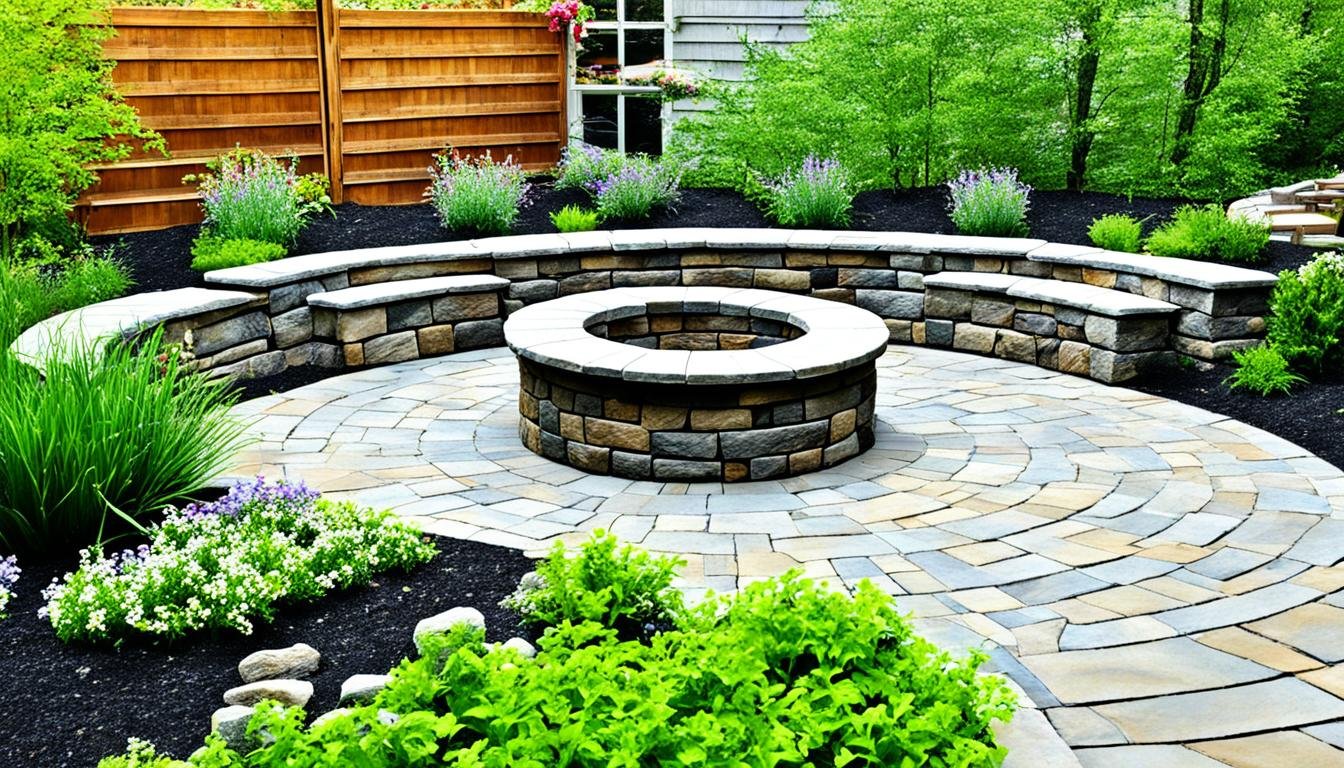
Did you know that hardscaping plays a crucial role in creating a perfect outdoor space? While landscaping focuses on the living elements like plants and flowers, hardscaping encompasses the non-living elements such as concrete, rocks, and man-made structures. But hardscaping is not just about aesthetics – it serves a purpose beyond that, improving the function, efficiency, and flow of your outdoor space.
Key Takeaways:
- Hardscaping refers to the non-living elements in landscaping design.
- It improves the function, efficiency, and flow of outdoor spaces.
- Hardscaping features can provide privacy, extension of indoor amenities, and increase the value of your home.
- Combining hardscaping with landscaping creates visually appealing and functional outdoor spaces.
- Proper maintenance ensures the longevity and visual appeal of hardscaping.
The Importance of Hardscaping in Outdoor Spaces
Hardscaping plays a crucial role in outdoor spaces as it improves the efficiency, flow, and look of the landscaping. It enhances both the functionality and aesthetics of your outdoor area, providing a multitude of benefits. Here are some key reasons why hardscaping is important:
Improved Functionality and Flow
Hardscaping elements such as walkways, patios, and retaining walls can level off sloping or uneven land, creating a smooth and accessible outdoor space. These structures ensure ease of movement and provide defined areas for different activities, enhancing the overall flow of your landscape design.
Enhanced Drainage
Hardscaping features like permeable pavers and well-planned drainage systems help divert water away from your property, preventing soil erosion and water accumulation. Proper drainage not only keeps your outdoor space dry and functional but also helps maintain the health of your plants and vegetation.
Privacy and Protection
Hardscape elements like fences, walls, and pergolas offer privacy by creating secluded areas within your outdoor space. These structures provide a barrier against external noise and prying eyes, allowing you to enjoy your yard in peace. Additionally, hardscaping features can provide protection from the elements, offering shade and shelter during hot summers or inclement weather.
Outdoor Amenities
One of the key advantages of hardscaping is the ability to create outdoor amenities. From elaborate kitchens and cozy fireplaces to relaxing decks and inviting seating areas, hardscaping allows you to extend your indoor living space outdoors, providing ample opportunities for entertainment, relaxation, and quality time with family and friends.
Seamless Integration with the House
Choosing hardscaping materials that complement the exterior of your house creates a seamless transition between indoor and outdoor spaces. This visual harmony enhances the overall aesthetic appeal of your property, giving it a cohesive and well-designed look.
Curb Appeal and Increased Home Value
Well-designed hardscaping significantly improves the curb appeal of your home, making it more eye-catching and attractive to potential buyers. A visually appealing outdoor space with functional hardscape elements can increase the value of your property, providing a return on investment.
By incorporating hardscaping into your outdoor design, you not only create a more functional and visually appealing space but also enhance the overall value and appeal of your property.
| Hardscaping Benefits |
|---|
| Improved functionality and flow |
| Enhanced drainage |
| Privacy and protection |
| Outdoor amenities |
| Seamless integration with the house |
| Curb appeal and increased home value |
Tips for Designing Hardscaping in Your Yard
When it comes to designing hardscaping in your yard, there are several key considerations that can help you create a visually stunning and functional outdoor space. Whether you’re starting from scratch or looking to enhance your existing hardscaping, these design tips will guide you in the right direction.
Create a Focal Point:
A well-designed hardscape should include a focal point that captures attention and adds visual interest to your yard. Whether it’s a stunning water feature, an elaborate fire pit, or a beautiful sculpture, incorporating a focal point will create a sense of intrigue and draw the viewer’s gaze. Choose a focal point that complements your overall design aesthetic and makes a statement.
Add Curved and Rounded Edges:
Straight lines and sharp angles are commonly associated with hardscaping design, but incorporating curved and rounded edges can add an element of authenticity and softness to your yard. Curved walkways or rounded patio areas can create a more natural flow and make the space feel more inviting. Consider using hardscaping materials that can be easily shaped to create these organic curves.
Consider Drainage:
Proper drainage is essential for maintaining the integrity of your hardscaping. Before you begin designing, take into account the natural slope of your yard and any drainage issues you may have. Incorporate hardscaping features such as retaining walls or stone steps to help divert water and prevent erosion. By addressing drainage considerations, you can ensure that your hardscaping remains stable and functional for years to come.
Choose the Right Materials:
The choice of hardscaping materials is crucial for achieving the desired look and feel of your outdoor space. Consider the style and architecture of your home, as well as your personal preferences, when selecting materials. Whether it’s natural stone, concrete pavers, or composite decking, choosing high-quality and durable materials will ensure that your hardscaping stands the test of time.
Blend Hardscaping with Greenery:
Mixing hardscaping with greenery and shrubs creates a harmonious and natural environment. Incorporate landscaping elements such as flower beds, planters, or climbing vines alongside your hardscape features. This combination softens the overall look and adds a touch of greenery that can create a more inviting and welcoming atmosphere.
Designing hardscaping in your yard is an opportunity to create a space that reflects your personal style and enhances your outdoor living experience. By following these design tips, you can achieve a hardscape design that is visually stunning, functional, and built to last.
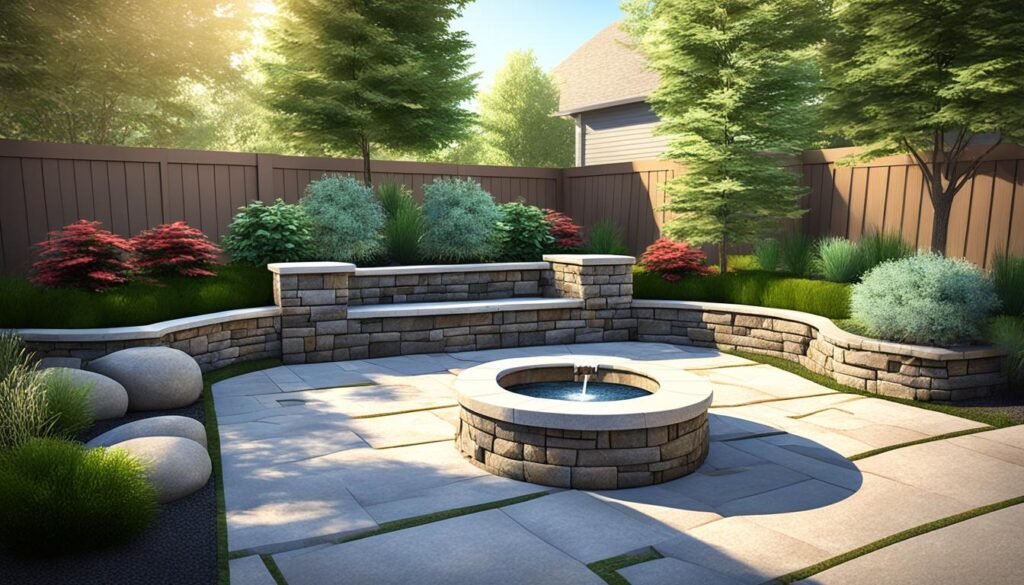
Maintenance Tips for Hardscaping
While hardscaping requires less maintenance compared to landscaping, regular care is still necessary to ensure its longevity. By following proper maintenance techniques, you can keep your hardscaping in excellent condition, enhancing the overall beauty of your outdoor space. Here are some essential tips to help you maintain your hardscaping:
Add a Protective Seal
To prevent damage and extend the life of hardscaping surfaces such as wood fences and patios, applying a protective seal is crucial. This seal acts as a barrier, shielding the materials from weather elements, UV rays, and potential stains. Regularly sealing your hardscaping features will help maintain their appearance and durability over time.
Clean Up Spills Immediately
Accidents happen, but it’s essential to clean up spills on hardscaping surfaces promptly. Whether it’s a food stain or a liquid spill, leaving it unattended can lead to permanent discoloration. Use a gentle cleaning solution and a soft brush to remove the spill and prevent staining.
Remove Unwanted Growth
Mold, mildew, and algae can quickly take hold on hardscaping surfaces, especially those in shaded or damp areas. Regularly inspect your hardscape for any signs of unwanted growth and remove it promptly. A mixture of water and mild detergent, along with a scrub brush, can effectively clean these surfaces without causing damage.
Choose the Right Cleaning Tools
The type of hardscaping material determines the cleaning tools you should use. Avoid using abrasive tools or harsh chemicals that can scratch or damage the surface. For example, a soft bristle brush or a pressure washer set to a low setting can be effective for cleaning many hardscaping materials.
Regular Maintenance Schedule
Establishing a regular maintenance routine is key to keeping your hardscaping in top shape. A regular cleaning schedule, along with periodic inspections and repairs, will prevent minor issues from becoming major problems. Additionally, addressing any issues promptly can save you time and money in the long run.
By following these maintenance tips and implementing a regular care routine, you can extend the life of your hardscaping, improve its appearance, and ensure the safety of your outdoor space.
| Maintenance Tips for Hardscaping | Benefits |
|---|---|
| Apply a protective seal to hardscaping surfaces | Prevents damage and extends the life of hardscaping materials |
| Clean up spills immediately | Prevents staining and maintains the appearance of hardscaping |
| Remove unwanted growth like mold and mildew | Prevents staining and maintains the cleanliness of hardscaping |
| Use the right cleaning tools for different hardscaping materials | Avoids damage and maintains the integrity of hardscaping |
| Establish a regular maintenance schedule | Keeps hardscaping in top shape and prevents major issues |
The Benefits of Combining Landscaping and Hardscaping
When it comes to creating a visually appealing outdoor space, the combination of landscaping and hardscaping can work wonders. By effectively blending the soft elements of landscaping, such as plants and flowers, with the harder elements of hardscaping, such as paved patios and stone walkways, you can achieve a harmonious and natural environment.
The integration of landscaping and hardscaping not only enhances the aesthetics but also offers numerous benefits. One significant advantage is the curb appeal it adds to your home. The seamless integration of greenery and hardscape features can make your property stand out, creating a welcoming and inviting atmosphere that catches the eye of passersby and potential buyers.
Moreover, the combination of landscaping and hardscaping can significantly increase the value of your home. A well-designed outdoor space that marries the beauty of nature with functional hardscape elements makes your property more desirable and appealing to prospective buyers. It becomes an attractive feature that sets your home apart from others in the market, potentially commanding a higher selling price.
By incorporating landscaping and hardscaping features, you can create an outdoor living area that is vibrant, functional, and versatile. Imagine having a patio surrounded by lush greenery, or a stone pathway leading to a tranquil garden retreat. These elements not only provide aesthetic value but also offer practical functionality, enabling you to enjoy your outdoor space to its fullest potential.
To visualize the benefits of combining landscaping and hardscaping, take a look at the table below that highlights key advantages:
| Benefits of Combining Landscaping and Hardscaping | Description |
|---|---|
| Curb Appeal | Creates an attractive and welcoming exterior that enhances the overall aesthetic appeal of your home. |
| Increased Home Value | Improves the market value of your property, making it more appealing to potential buyers. |
| Functional Outdoor Space | Provides a versatile and functional outdoor living area for relaxation, entertainment, and hosting gatherings. |
| Natural Environment | Blends the soft elements of nature with the solid structures, creating a cohesive and harmonious outdoor environment. |
| Personal Enjoyment | Offers a serene and beautiful outdoor space where you can unwind and connect with nature. |
By harnessing the complementary forces of landscaping and hardscaping, you can transform your outdoor space into a haven that not only enhances your quality of life but also increases the value and desirability of your home.
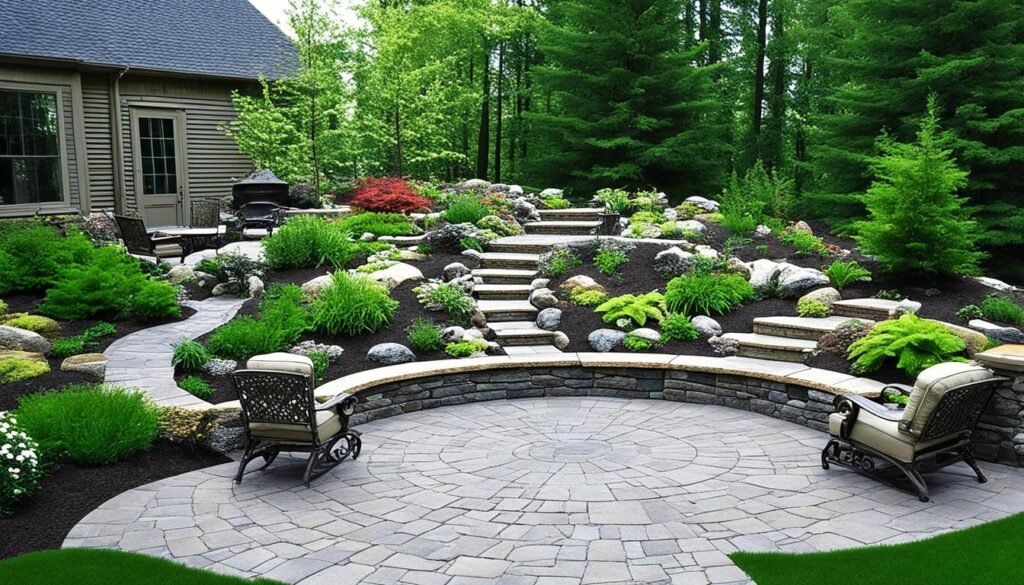
Exploring Hardscape Elements in Landscaping
In landscaping, hardscape elements play a crucial role in adding structure, functionality, and aesthetic appeal to outdoor spaces. From patios and walkways to water features and grill surrounds, hardscaping features offer endless possibilities for creating a captivating landscape design. Let’s dive into the different types of hardscaping elements and the common materials used to bring them to life.
Hardscape Elements
- Patios: These outdoor living spaces provide a designated area for relaxation, dining, and entertaining.
- Walkways: Whether they’re made of pavers, stones, or concrete, walkways guide visitors through the landscape and connect different areas.
- Sitting Walls: These low walls offer both seating and visual boundaries, adding depth and interest to the landscape.
- Retaining Walls: Used to level sloping terrain, retain soil, and create terraced gardens, retaining walls are an essential hardscaping element.
- Water Features: From elegant fountains to serene ponds, water features bring tranquility and visual interest to the outdoor space.
- Fire Pits: Perfect for gathering around and enjoying cozy evenings outdoors, fire pits add warmth and ambiance to any landscape.
- Grill Surrounds: Built-in grill surrounds transform the outdoor cooking experience, combining functionality and style.
- Pergolas: These overhead structures provide shade, define outdoor living areas, and add architectural interest.
- Landscape Lighting: Illuminating the landscape enhances safety, highlights focal points, and extends hours of outdoor enjoyment.
Common Hardscape Materials
When it comes to hardscape materials, several options are commonly used to create durable and visually appealing features:
- Concrete: Versatile and available in various finishes, concrete is commonly used for patios, walkways, and retaining walls.
- Bricks: With their timeless appeal, bricks are often used for paths, walls, and fire pits.
- Stones: Natural stones like flagstone, limestone, and granite are popular choices for creating unique and rustic hardscape elements.
- Wood: Wood is commonly used for pergolas, decks, and grill surrounds, adding warmth and a natural aesthetic to the landscape.
Each hardscape element serves a purpose, whether it’s providing seating, enhancing accessibility, or adding visual interest. The choice of materials and features depends on personal preference and the overall design goals you have for your outdoor space.
Now that we’ve explored the various hardscape elements and materials, it’s time to continue our journey by delving into the essential maintenance tips for hardscaping.
Conclusion
Hardscaping is an essential aspect of landscaping design that offers numerous benefits for transforming your outdoor space. By incorporating hardscape elements such as patios, walkways, and water features, you can create an inviting and enjoyable area for relaxation, entertainment, and hosting guests.
Proper design, maintenance, and integration with landscaping elements enhance the overall appeal and value of your home. Hardscaping not only improves the functionality and flow of your outdoor space but also adds curb appeal and increases the resale value of your property.
Whether you’re hardscaping your yard for personal enjoyment or for investment purposes, it is a decision that can greatly enhance your outdoor living experience. With the right hardscape design and materials, you can transform your outdoor space into a beautiful and functional oasis that you and your family will enjoy for years to come.

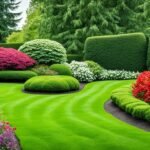
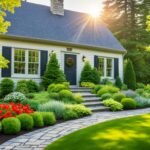
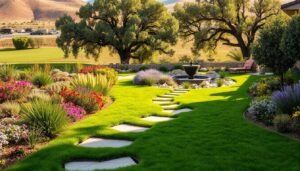
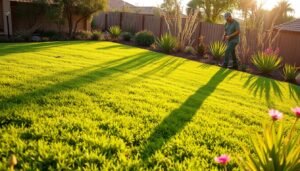

No comment yet, add your voice below!